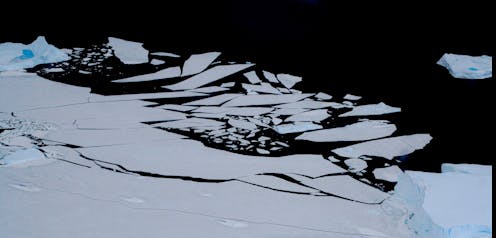how Antarctica's 'landfast' ice is dwindling and why that's bad news
- Written by Alexander Fraser, Senior Researcher in Antarctic Remote Sensing, University of Tasmania

There’s more to Antarctic ice than meets the eye. Sea ice is not a uniform crust overlying the salty Southern Ocean.
Our new research[1] is the first to review the many crucial roles of “landfast” sea ice[2] around Antarctica. Landfast ice is frozen seawater that is fastened to the coast. It acts like a belt around the Antarctic coast, regulating the flow of ice shelves and glaciers into the sea. And it’s crucial habitat for Weddell seals and emperor penguins.
Satellites can easily estimate the horizontal extent of sea ice, but determining the type of ice is far more difficult. Our deeper analysis of satellite images reveals landfast sea ice extent declined to a record low of just 123,200 square km in March 2022. That’s well below the normal March range of 168,600-295,200 square km.
Much of the ice lost in 2022 had been present since 2000, when high-quality records began. If this trend persists, the consequences for the climate and for Southern Ocean ecosystems could be catastrophic.
Read more: Antarctica's heart of ice has skipped a beat. Time to take our medicine[3]
Getting a grip on landfast ice
Antarctic sea ice drives the circulation of the world’s oceans. The “overturning” circulation begins in Antarctica when very salty, dense brine (created as the ice forms) sinks to the bottom of the ocean. This “bottom water” spreads away from Antarctica to reach the northern hemisphere.
This crucial circulation is projected to slow due to glacial melt[4], because the input of more buoyant fresh water dilutes the denser brine. This raises the spectre of a further slowing or worse, total shut down of deep ocean currents as in the disaster movie, “The Day After Tomorrow[5]”. We know concentrated regions of sea ice formation tend to occur next to landfast ice, so the changes we are seeing are likely to further reduce this deep ocean circulation.
Read more: Torrents of Antarctic meltwater are slowing the currents that drive our vital ocean 'overturning' – and threaten its collapse[6]
Global climate models are not particularly skilful[7] at reproducing the recent history of Antarctic sea ice, giving limited confidence in our ability to predict its future. There are many reasons for this, but one of the main ones is an overly simplistic representation of the sea ice.
Landfast sea ice is not represented in any global climate model. These models treat all sea ice as if it’s able to drift, whereas in reality up to 15% of ice should be held still by being anchored to land or grounded icebergs.
This is a big problem because, as our study reveals, if we don’t properly simulate it, we are likely to get all kinds of inaccurate flow-on effects, including an incorrect amount of sea ice (and hence dense water) produced by our models?.
Wildlife depends on landfast ice
Landfast ice supports a unique community of algae, krill, small crustaceans called copepods, molluscs and fish. They are adapted to live within and below the ice where conditions are harsh.
These species form a complex food web around ice algae, using the ice as a nursery ground. Life within landfast ice requires wide-ranging survival strategies. Drastic changes could mean cascading effects on the entire food web.
Seals and penguins rely on this environment for resting, hunting and breeding. Emperor penguins have a unique approach to raising a family that requires stable ice, which only landfast ice can provide. Reduced ice extent, increased fragmentation and earlier breakup can lead to population declines of this iconic species.
Deeper knowledge is crucial for climate forecasts
Only a few areas of Antarctic landfast ice are regularly sampled. These areas are found near Antarctic research stations and are generally separated by thousands of kilometres of coast.
Additionally, scientists can often only safely collect sea ice cores from smooth ice thick enough to support people. So sampling is skewed to favour the unbroken crème brûlée-type crust over the shattered meringue of rough landfast ice.
To better understand rough landfast ice and a slew of other poorly understood ice types, we need repeat ice core measurements along with more detailed satellite studies. We also need the capability to model each ice type accurately.
Our research has ensured landfast ice is earmarked for inclusion in the next iteration of our national climate model, which aims to better simulate the interactions between sea ice of all types and the Southern Ocean. Without this ability, we are missing a key ingredient in the recipe of Australia’s climate future.
Read more: Record low Antarctic sea ice is another alarming sign the ocean's role as climate regulator is changing[8]
References
- ^ new research (agupubs.onlinelibrary.wiley.com)
- ^ “landfast” sea ice (www.antarctica.gov.au)
- ^ Antarctica's heart of ice has skipped a beat. Time to take our medicine (theconversation.com)
- ^ projected to slow due to glacial melt (www.abc.net.au)
- ^ The Day After Tomorrow (en.wikipedia.org)
- ^ Torrents of Antarctic meltwater are slowing the currents that drive our vital ocean 'overturning' – and threaten its collapse (theconversation.com)
- ^ not particularly skilful (agupubs.onlinelibrary.wiley.com)
- ^ Record low Antarctic sea ice is another alarming sign the ocean's role as climate regulator is changing (theconversation.com)

















